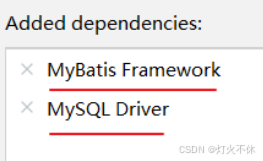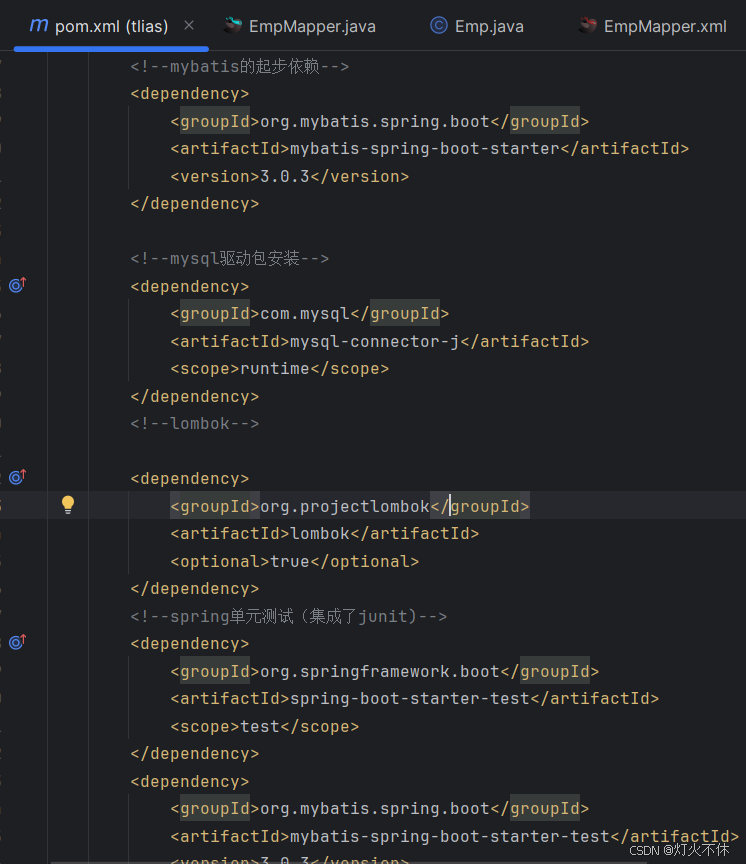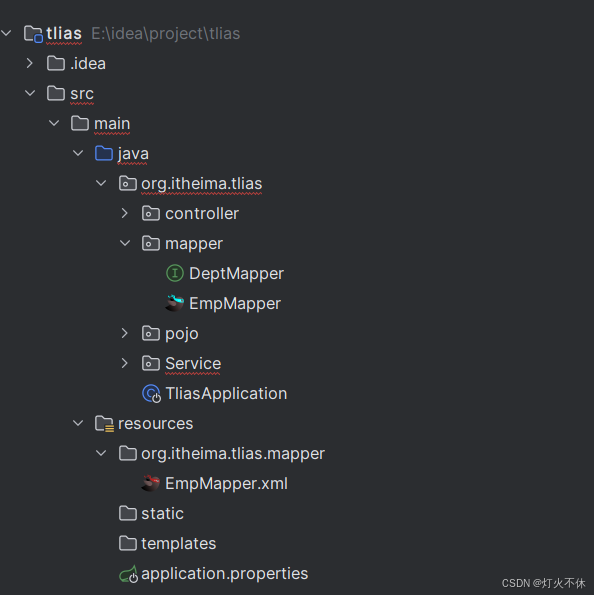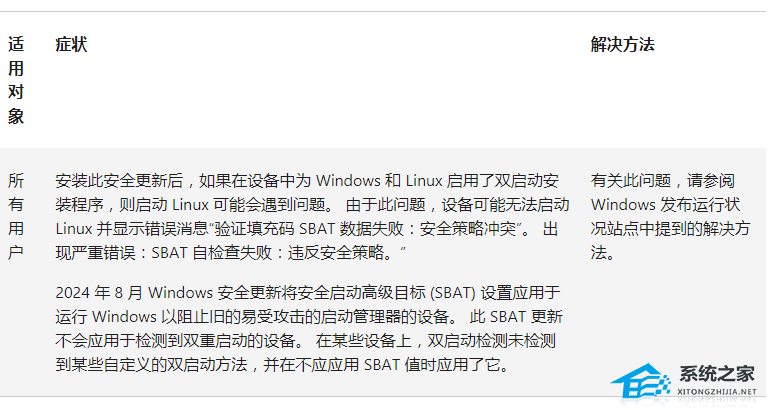目录
Mybatis
Mybatis入门操作步骤
1.准备工作
创建springboot工程
创建数据库表和实体类
连接数据库
创建接口XxxMapper
2.数据库连接池
Lombok
使用
Mybatis
准备工作
删除
日志输入
参数占位符
新增
更新
查询
驼峰命名
条件查询
XML
创建XML文件
编写XML映射文件
Mybatis动态SQL
条件查询
更新员工
Mybatis
MyBatis是一款优秀的 持久层 框架,用于简化JDBC的开发。Mybatis框架,就是对原始的JDBC程序的封装。
JDBC: ( Java DataBase Connectivity ),就是使用Java语言操作关系型数据库的一套API。
MyBatis本是 Apache的一个开源项目iBatis,2010年这个项目由apache迁移到了google code,并
且改名为MyBatis 。2013年11月迁移到Github。
持久层:指的是就是数据访问层(dao),是用来操作数据库的。
框架:是一个半成品软件,是一套可重用的、通用的、软件基础代码模型。在框架的基础上进行软
件开发更加高效、规范、通用、可拓展。
使用Mybatis操作数据库,就是在Mybatis中编写SQL查询代码,发送给数据库执行,数据库执行后
返回结果。
Mybatis会把数据库执行的查询结果,使用实体类封装起来(一行记录对应一个实体类对象)

Mybatis入门操作步骤
1. 准备工作(创建springboot工程、数据库表user、实体类User)
2. 引入Mybatis的相关依赖,配置Mybatis(数据库连接信息)
3. 编写SQL语句(注解/XML)
1.准备工作
创建springboot工程

创建springboot时引入MyBatis Framework和MySQL Driver
在pom.xml文件中,自动导入了依赖

创建数据库表和实体类
在数据库中创建表user,并创建对应的实体类User
连接数据库

在文件application.properties中配置增加代码
全部都是 spring.datasource.xxxx 开头。
#驱动类名称
spring.datasource.driver-class-name=com.mysql.cj.jdbc.Driver
#数据库连接的url
spring.datasource.url=jdbc:mysql://localhost:3306/mybatis
#连接数据库的用户名
spring.datasource.username=root
#连接数据库的密码
spring.datasource.password=1234记得修改url,使用自己数据库的用户名和密码
创建接口XxxMapper

在接口文件中加入代码
@Mapper
public interface UserMapper {
//查询所有用户数据
@Select("select id, name, age, gender, phone from user")
public List<User> list();
}@Mapper注解:表示是mybatis中的Mapper接口
程序运行时,框架会自动生成接口的实现类对象(代理对象),并给交Spring的IOC容器管理
@Select注解:代表的就是select查询,用于书写select查询语句
1. application.properties
#驱动类名称
spring.datasource.driver-class-name=com.mysql.cj.jdbc.Driver
#数据库连接的url
spring.datasource.url=jdbc:mysql://localhost:3306/mybatis
#连接数据库的用户名
spring.datasource.username=root
#连接数据库的密码
spring.datasource.password=1234
2. Mapper接口(编写SQL语句)
@Mapper
public interface UserMapper {
@Select("select id, name, age, gender, phone from user")
public List<User> list();
}
2.数据库连接池
数据库连接池是个容器,负责分配、管理数据库连接(Connection)
没有使用数据库连接池:
客户端执行SQL语句:要先创建一个新的连接对象,然后执行SQL语句,SQL语句执行后又需
要关闭连接对象从而释放资源,每次执行SQL时都需要创建连接、销毁链接,这种频繁的重复
创建销毁的过程是比较耗费计算机的性能。
使用数据库连接池
程序在启动时,会在数据库连接池(容器)中,创建一定数量的Connection对象
允许应用程序重复使用一个现有的数据库连接,而不是再重新建立一个
客户端在执行SQL时,先从连接池中获取一个Connection对象,然后在执行SQL语句,SQL语句执
行完之后,释放Connection时就会把Connection对象归还给连接池(Connection对象可以复用)
释放空闲时间超过最大空闲时间的连接,来避免因为没有释放连接而引起的数据库连接遗漏
客户端获取到Connection对象了,但是Connection对象并没有去访问数据库(处于空闲),数据库连
接池发现Connection对象的空闲时间 > 连接池中预设的最大空闲时间,此时数据库连接池就会自
动释放掉这个连接对象
数据库连接池的好处:
1. 资源重用
2. 提升系统响应速度
3. 避免数据库连接遗漏
常见的数据库连接池:
C3P0 、DBCP 、Druid 、Hikari (springboot默认)
现在使用更多的是:Hikari、Druid (性能更优越) 、Hikari(追光者) [默认的连接池]
如果想把默认的数据库连接池切换为Druid数据库连接池,只需要完成以下两步操作即可:
1. 在pom.xml文件中引入依赖
<dependency>
<!-- Druid连接池依赖 -->
<groupId>com.alibaba</groupId>
<artifactId>druid-spring-boot-starter</artifactId>
<version>1.2.8</version>
</dependency>
spring.datasource.driver-class-name=com.mysql.cj.jdbc.Driver
spring.datasource.url=jdbc:mysql://localhost:3306/mybatis
spring.datasource.username=root
spring.datasource.password=1234
优点
1. 数据库连接四要素(驱动、链接、用户名、密码),都配置在springboot默认的配置文件
application.properties中
2. 查询结果的解析及封装,由mybatis自动完成映射封装,我们无需关注
3. 在mybatis中使用了数据库连接池技术,从而避免了频繁的创建连接、销毁连接而带来的资源浪
费。
使用SpringBoot+Mybatis的方式操作数据库,能够提升开发效率、降低资源浪费
1. application.properties
2. Mapper接口(编写SQL语句)
3. 数据库连接池
在前面我们所讲解的mybatis中,使用了数据库连接池技术,避免频繁的创建连接、销毁连接而带来的资源浪费。
Lombok
Lombok是一个实用的Java类库,可以通过简单的注解来简化和消除一些必须有但显得很臃肿的Java代码。
通过注解的形式自动生成构造器、getter/setter、equals、hashcode、toString等方法,并可以自 动化生成日志变量,简化java开发、提高效率。

使用
<!-- 在springboot的父工程中,已经集成了lombok并指定了版本号,故当前引入依赖时不需要指定 version -->
<dependency>
<groupId>org.projectlombok</groupId>
<artifactId>lombok</artifactId>
</dependency>
第2步:在实体类上添加注解
import lombok.Data;
@Data //getter方法、setter方法、toString方法、hashCode方法、equals方法
@NoArgsConstructor //无参构造
@AllArgsConstructor//全参构造
public class User {
private Integer id;
private String name;
private Short age;
private Short gender;
private String phone;
}
Mybatis
准备工作
1. 准备数据库表
2. 创建一个新的springboot工程,选择引入对应的起步依赖(mybatis、mysql驱动、lombok)

3. application.properties中引入数据库连接信息

4. 创建对应的实体类 Emp(实体类属性采用驼峰命名)
5. 准备Mapper接口 EmpMapper

准备好后,项目工程结构目录如下

删除
SQL语句
-- 删除 id=17 的数据delete from emp where id = 17 ;
接口方法实现删除操作
@Mapper
public interface EmpMapper {
@Delete("delete from emp where id = #{id}")//使用#{key}方式获取方法中的参数值
public void delete(Integer id);
}
日志输入
在Mybatis当中我们可以借助日志,查看到sql语句的执行、执行传递的参数以及执行结果。具体操作如下:
1. 打开application.properties文件
2. 开启mybatis的日志,并指定输出到控制台
#指定mybatis输出日志的位置, 输出控制台
mybatis.configuration.log-impl=org.apache.ibatis.logging.stdout.StdOutImpl
预编译SQL的两个优势:
性能更高:预编译SQL,编译一次之后会将编译后的SQL语句缓存起来,后面再次执行这条语句
时,不会再次编译。(只是输入的参数不同)
更安全(防止SQL注入):将敏感字进行转义,保障SQL的安全性。
参数占位符
在Mybatis中提供的参数占位符有两种:${...} 、#{...}
#{...}
执行SQL时,会将#{…}替换为?,生成预编译SQL,会自动设置参数值
使用时机:参数传递,都使用#{…}
${...}
拼接SQL。直接将参数拼接在SQL语句中,存在SQL注入问题
使用时机:如果对表名、列表进行动态设置时使用
注意事项:在项目开发中,建议使用#{...},生成预编译SQL,防止SQL注入安全
新增
SQL语句
insert into emp(username, name, gender, image, job, entrydate, dept_id,
create_time, update_time) values ('songyuanqiao','宋远桥',1,'1.jpg',2,'2012-10-
09',2,'2022-10-01 10:00:00','2022-10-01 10:00:00');
接口方法实现删除操作
@Mapper
public interface EmpMapper {
@Insert("insert into emp(username, name, gender, image, job, entrydate,
dept_id, create_time, update_time) values (#{username}, #{name}, #{gender}, #
{image}, #{job}, #{entrydate}, #{deptId}, #{createTime}, #{updateTime})")
public void insert(Emp emp);
}
更新
SQL语句
update emp set username = 'linghushaoxia' , name = ' 令狐少侠 ' , gender = 1 , image ='1.jpg' , job = 2 , entrydate = '2012-01-01' , dept_id = 2 , update_time = '2022-10-01 12:12:12' where id = 18 ;
接口方法实现更新操作
@Mapper
public interface EmpMapper {
/**
* 根据id修改员工信息
* @param emp
*/
@Update("update emp set username=#{username}, name=#{name}, gender=#{gender},
image=#{image}, job=#{job}, entrydate=#{entrydate}, dept_id=#{deptId},
update_time=#{updateTime} where id=#{id}")
public void update(Emp emp);
}
查询
SQL语句
select id, username, password , name, gender, image, job, entrydate, dept_id,create_time, update_time from emp;
接口方法事项查询操作
@Mapperpublic interface EmpMapper {@Select ( "select id, username, password, name, gender, image, job, entrydate,dept_id, create_time, update_time from emp where id=#{id}" )public Emp getById ( Integer id );}
驼峰命名
# 在 application.properties 中添加:mybatis.configuration.map-underscore-to-camel-case = true
条件查询
SQL语句
select id, username, password , name, gender, image, job, entrydate, dept_id,create_time, update_timefrom empwhere name like '% 张 %'and gender = 1and entrydate between '2010-01-01' and '2020-01-01 'order by update_time desc ;
接口方法实现条件查询
方法一
@Mapperpublic interface EmpMapper {
@Select("select * from emp " +
"where name like '%${name}%' " +
"and gender = #{gender} " +
"and entrydate between #{begin} and #{end} " +
"order by update_time desc")
public List<Emp> list(String name, Short gender, LocalDate begin, LocalDate
end);
}
1. 方法中的形参名和SQL语句中的参数占位符名保持一致
2. 模糊查询使用${...}进行字符串拼接,这种方式呢,由于是字符串拼接,并不是预编译的形
式,所以效率不高、且存在sql注入风险。
性能低、不安全、存在SQL注入风险
方法二
@Mapper
public interface EmpMapper {
@Select("select * from emp " +
"where name like concat('%',#{name},'%') " +
"and gender = #{gender} " +
"and entrydate between #{begin} and #{end} " +
"order by update_time desc")
public List<Emp> list(String name, Short gender, LocalDate begin, LocalDate
end);
}
性能高、安全
XML
Mybatis的开发有两种方式
1. 注解
2. XML
使用Mybatis的注解方式,主要是来完成一些简单的增删改查功能。如果需要实现复杂的SQL功能,建议
使用XML来配置映射语句,也就是将SQL语句写在XML配置文件中。
在Mybatis中使用XML映射文件方式开发,需要符合一定的规范:
1. XML映射文件的名称与Mapper接口名称一致,并且将XML映射文件和Mapper接口放置在相同包下(同包同名)
2. XML映射文件的namespace属性为Mapper接口全限定名一致
3. XML映射文件中sql语句的id与Mapper接口中的方法名一致,并保持返回类型一致。

<select>标签:就是用于编写select查询语句的。
resultType属性,指的是查询返回的单条记录所封装的类型。
创建XML文件



编写XML映射文件
在XML映射文件中写入
<?xml version="1.0" encoding="UTF-8" ?>
<!DOCTYPE mapper
PUBLIC "-//mybatis.org//DTD Mapper 3.0//EN"
"https://mybatis.org/dtd/mybatis-3-mapper.dtd">
<mapper namespace="">
</mapper>
Mybatis动态SQL
<if> :用于判断条件是否成立。使用test属性进行条件判断,如果条件为true,则拼接SQL
<if test="条件表达式">
要拼接的sql语句
</if>
条件查询
原SQL语句
<select id="list" resultType="com.itheima.pojo.Emp">
select * from emp
where name like concat('%',#{name},'%')
and gender = #{gender}
and entrydate between #{begin} and #{end}
order by update_time desc
</select>
动态SQL语句
<select id="list" resultType="com.itheima.pojo.Emp">
select * from emp
where
<if test="name != null">
name like concat('%',#{name},'%')
</if>
<if test="gender != null">
and gender = #{gender}
</if>
<if test="begin != null and end != null">
and entrydate between #{begin} and #{end}
</if>
order by update_time desc
</select>
使用 <where> 标签代替SQL语句中的where关键字
<where> 只会在子元素有内容的情况下才插入where子句,而且会自动去除子句的开头的AND或
OR
动态SQL语句
<select id="list" resultType="com.itheima.pojo.Emp">
select * from emp
<where>
<!-- if做为where标签的子元素 -->
<if test="name != null">
and name like concat('%',#{name},'%')
</if>
<if test="gender != null">
and gender = #{gender}
</if>
<if test="begin != null and end != null">
and entrydate between #{begin} and #{end}
</if>
</where>
order by update_time desc
</select>
更新员工
修改Maper接口
@Mapper
public interface EmpMapper {
//删除@Update注解编写的SQL语句
//update操作的SQL语句编写在Mapper映射文件中
public void update(Emp emp);
}
修改XML映射文件
<?xml version="1.0" encoding="UTF-8" ?>
<!DOCTYPE mapper
PUBLIC "-//mybatis.org//DTD Mapper 3.0//EN"
"https://mybatis.org/dtd/mybatis-3-mapper.dtd">
<mapper namespace="com.itheima.mapper.EmpMapper">
<!--更新操作-->
<update id="update">
update emp
set
<if test="username != null">
username=#{username},
</if>
<if test="name != null">
name=#{name},
</if>
<if test="gender != null">
gender=#{gender},
</if>
<if test="image != null">
image=#{image},
</if>
<if test="job != null">
job=#{job},
</if>
<if test="entrydate != null">
entrydate=#{entrydate},
</if>
<if test="deptId != null">
dept_id=#{deptId},
</if>
<if test="updateTime != null">
update_time=#{updateTime}
</if>
where id=#{id}
</update>
</mapper>
使用 <set> 标签代替SQL语句中的set关键字
<set> :动态的在SQL语句中插入set关键字,并会删掉额外的逗号。(用于update语句中)
<?xml version="1.0" encoding="UTF-8" ?>
<!DOCTYPE mapper
PUBLIC "-//mybatis.org//DTD Mapper 3.0//EN"
"https://mybatis.org/dtd/mybatis-3-mapper.dtd">
<mapper namespace="com.itheima.mapper.EmpMapper">
<!--更新操作-->
<update id="update">
update emp
<!-- 使用set标签,代替update语句中的set关键字 -->
<set>
<if test="username != null">
username=#{username},
</if>
<if test="name != null">
name=#{name},
</if>
<if test="gender != null">
gender=#{gender},
</if>
<if test="image != null">
image=#{image},
</if>
<if test="job != null">
job=#{job},
</if>
<if test="entrydate != null">
entrydate=#{entrydate},
</if>
<if test="deptId != null">
dept_id=#{deptId},
</if>
<if test="updateTime != null">
update_time=#{updateTime}
</if>
</set>
where id=#{id}
</update>
</mapper>
文中部分内容及图片来自黑马程序员



















